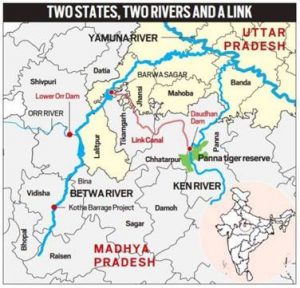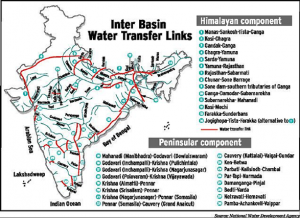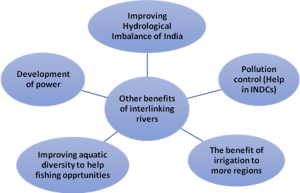THE CONTEXT: The Centre constituted the Ken-Betwa Link Project Authority to implement the first initiative under the national river interlinking policy, which seeks to bring nearly 11 lakh hectares of land under irrigation in the parched Bundelkhand region straddling Uttar Pradesh and Madhya Pradesh. Earlier, the finance minister allocated Rs 44,605 crore for the implementation of the Ken-Betwa River link project for irrigation of the Bundle Khand region in the Union Budget 2022-23.
KEN BETWA LINK PROJECT: OVERVIEW
- It is a river-interlinking project that aims to transfer surplus water from the Ken river in Madhya Pradesh to Betwa in Uttar Pradesh to irrigate the drought-prone Bundelkhand region. Both Ken and Betwa are the tributaries of the Yamuna.
- It is the first river interlinking project, among the 16 similar projects planned under the Peninsular Rivers Development of the National Perspective Plan (NPP).
- The main objective of the NPP is the transfer of water from river basins with surplus water to those with scarce water, for tackling the problem of water scarcity. The NPP comprises the Himalayan Rivers Development and Peninsular Rivers Development.
- The Ken Betwa River linking project, the construction schedule for which has been planned for eight years, will be executed in two phases:
- Phase-I: In the first phase, the Daudhan dam complex and its appurtenances, such as low-level tunnel, high-level tunnel, 221-kilometre Ken-Betwa link canal, and powerhouses will be completed.
- Phase-II: In the second phase, the Ken Betwa link project development works will be started for the lower Orr dam, Bina complex project, and Kotha barrage.

KEN BETWA RIVER LINKING PROJECT TIMELINE
- August 1980: The National Perspective Plan(NPP) is formulated.
- August 2005: MoU signed by state governments of MP, UP, and the ce
- central government to prepare the DPR for the project.
- April 2010: The National Water Development Agency (NWDA) completes the DPR for phase-I of the KBLP.
- January 2014: The NWDA completes the DPR for phase II of the project.
- September 2014: Special Committee on interlinking of rivers (ILR) was constituted, for implementing the ILR program.
- April 2015: A task force for interlinking of rivers was constituted by MoWR, River Development, and Ganga Rejuvenation.
- March 2021: Governments of UP and MP sign an MoU with the Jal Shakti Ministry for implementing the Ken betwa river linking project.
- February 2022: Government announces budget allocation of Rs 44,605 crore for the project during the Union Budget 2022-23.
KEN BETWA PROJECT COST
- The project will be completed at an estimated cost of around Rs 44,605 crores. The Ken-Betwa Link Project Authority, a special purpose vehicle (SPV) for implementing the project will be formed and the central government will bear 90% of the total project cost, while the states will bear the rest (UP and MP).
A Special Purpose Vehicle (SPV) for the project:
- A Special Purpose Vehicle (SPV) called Ken-Betwa Link Project Authority (KBLPA) will be set up to implement the project. In fact, the Centre has set in motion the process of creation of the National Interlinking of Rivers Authority (NIRA), an independent, autonomous body for planning, investigation, financing, and implementation of the interlinking of river (ILR) projects in the country.
- The NIRA will have powers to set up SPV for individual link projects.
KEN BETWA RIVER LINKING PROJECT: BENEFITS AND IMPACT
- The government envisions the interlinking of rivers as a top priority towards sustainable development of water resources in India. The Ken Betwa link project has been planned as a multi-purpose project for providing several benefits in terms of better utilisation of water resources and addressing the water scarcity in several parts of the Bundelkhand region.
- The region is prone to recurring drought conditions that have impacted socio-economic development in the area. Moreover, the location is not rich in groundwater due to the hard rock and marginal alluvium terrain. Hence, the project will help in utilising the floodwater during monsoon and stabilise the availability of water during lean months, especially in drought years.
- The Ken and Betwa river project will also provide annual irrigation and hydropower generation. The districts that will benefit from the Ken Betwa link pariyojna include Chhatarpur, Tikamgarh, Sagar, Damoh, Datia, Vidisha, Shivpuri, and Raisen and Panna in Madhya Pradesh and Jhansi, Mahoba, Banda and Lalitpur in Uttar Pradesh. Due to the project, as many as 62 lakh people in the Bundelkhand region will also experience an improved drinking water supply.
SOCIAL, ECONOMIC, AND ENVIRONMENTAL IMPACTS OF THE PROJECT
Social Impact: A major goal of the project is to provide irrigation to the water-scarce Bundelkhand region. According to the Water Resources Ministry, a total of 10 villages consisting of 1,585 families are likely to be affected by this project.
- Loss of Land: In all 6422.62 ha of private lands would be lost by the project affected families for the construction of the Daudhan dam and other project components along with the canal network under the project. Besides, as per the project design, about 5339.00 ha of forest lands would also be brought under various project components. This indicates that the landowners would lose their landed properties.
- Loss of Livelihood: About 72 percent of households would become landless, nearly 21 percent would become marginal farmers and almost 7 percent will fall under the small farmer category. As a result of land acquisition, the project affected big farmers who would lose their big farmer status.
- Loss of Employment: Due to land acquisition, several families, who become landless, would lose their total self-employment, who otherwise have been engaged in their farming activity.
- Loss of Income: Project-affected household’s socio-economic environment will affect their family life due to loss of land, livelihood, and employment resulting in reduced family income.
Economic Impact:
- This project will prove several economic benefits like the development of agro-based industries, and transportation and storage facilities.
- Increased farm supplies, production, and consumption of fertilizer, pesticide, farm equipment, and employment generation.
- Economic benefits of irrigation water supply include various benefits on, crop production; recharges groundwater, animal husbandry, farm equipment, and agro-processing.
- Livestock production, especially milk, is a major part of the agricultural economy in the Bundelkhand region. Under the project, a large water body will be coming up by constructing a dam and will certainly recharge and increase the groundwater levels in the project area. This will help the farming community as well as other water users who depended on groundwater facilities.
- The project has good potential, particularly because of the close proximity of the Daudhan dam site to Khajurao for recreation and tourism development.
- Provision for the development of tourist huts, and picnic spots has been made on the periphery of Rangwan reservoir (about 9 km from the Daudhan dam site).
- The negative part of the KBLP project is crop and livestock production loss due to the submergence of the crop area upstream of the reservoir.
Environmental Impact:
- This project would submerge an area of 9,000 hectares. Of which 5,258 hectares are forest land (including 4,141 hectares of Panna Tiger Reserve).
- River diversion would bring drastic changes in the physical and chemical compositions of the sediment load, river morphology, and the shape of the delta formed at the river mouth. All these have serious economic and livelihood implications that are merely ignored by the project.
- The project may also lead to a loss of two million trees.
- The land use land cover and vegetation data show that tree density and diversity are comparatively higher in the submerged area.
- The regeneration pattern also shows that the seedling diversity and richness and sapling density diversity and richness are high in the submerged area.
- Minimum flow in the Ken River is adequate to dilute the untreated sewage. Hence the impact on the surface water quality is negligible, which will still be reduced by sewage treatment measures.
- There are valuable timber trees that are going to be submerged.
WILL THE PROJECT AFFECT THE PANNA TIGER RESERVE?
- Panna Tiger Reserve is one of the country’s important and successful tiger recovery reserves.
- A species recovery plan was developed to reinforce the tiger population, because of which the tiger population has increased from 0 in 2009 to 54 in 2019.
- Panna Tiger Reserve was included in the global network of biosphere reserves by the United Nations Educational, Scientific, and Cultural Organisation (UNESCO) in 2020.
- The UNESCO cited PTR as a critical tiger habitat.
- The Project will lead to the submergence of a major portion of the core area of the Panna Tiger Reserve in Madhya Pradesh, triggering a major loss of the tiger and its major prey species such as chital and sambar.
- The project may incur an estimated loss of 58.03 square kilometers (10.07 percent) of critical tiger habitat (CTH) in the reserve.
- There will be an indirect loss of 105.23 sq km of CTH because of habitat fragmentation and loss of connectivity due to submergence.
- The total area submerged would be 86.50 sq km, of which 57.21 sq km lies within Panna Tiger Reserve. This will account for 65.50 percent of total submergence.
THE INTERLINKING OF RIVERS
The National Perspective Plan (NPP) presented the development of water resources through the inter-basin transfer and the transfer of water from water surplus basins to water-deficit basins. The interlinking of rivers is a large-scale civil engineering project that aims to effectively manage water resources in India under the NPP.

Positives of interlinking of rivers for multi-dimensional inter-related problems
Droughts: The drought-prone regions like Vidharbha face perennial droughts. The interlinking of seasonal peninsular rivers with their Himalayan counterparts may be a gamechanger for this region’s agriculture and food security prospects.
Floods: Interlinking of rivers will contribute to flood and drought hazard mitigation for India. It will most likely eradicate the flooding problems which recur in the northeast and the north every year. For example, floodwaters of the Kosi river could be diverted to other east-flowing rivers.
Improve the inland navigation:
- Interlinking of rivers will create a network of navigation channels. Water transport is cheaper, less-polluting compare to road and railways.
- Further, the interlinking of rivers can ease the pressure on railways and roads also.
- More importantly, India has the huge untapped potential of inland water transport, which can be a game-changer in the logistics aspect and, thus, overall costs of goods & services.

Negatives of interlinking of rivers for multi-dimensional inter-related problems:
- Ecological challenges: The ambitious project will divert forest areas and submergence fertile land leading to deforestation and soil- erosion. For example, the Ken-Betwa link projects have reduced 8% of the forest land of Panna National Park. Also, river diversion may bring significant changes in the physical and chemical compositions of the sediment load, river morphology, and the shape of the delta formed in the river basin.
- Social challenges: Reconstruction and rehabilitation of millions of people in and around the river catchments could face significant psychological damage, resulting in social unrest and protests in the initial stages.
- Political challenges: India’s inter-state river doesn’t have a bright history (for example, the Cauvery River dispute). Further, water being a state subject demands sustained inter-state cooperation which may be a challenge given the diversity India offers.
THE WAY FORWARD:
- The interlinking of rivers in India has both pros and cons. Implementing the project in its entirety may be a challenge in present times. Therefore, the government must opt for a decentralized method of implementation instead of a centralized one.
- Inter-linking projects should receive the nod only after appropriate EIA and environmental clearances.
- Further, we must look for alternatives for efficient water use in India. For instance, measures like efficient water use in agriculture (per drop more crop), resourceful rainwater harvesting in drought-prone areas, and so on can be looked upon to liberate India from the persistent water stress.
- Adopt Alternative measures: A case study of Jakhni village of Banda district
- A 2019 NITI Aayog report mentioned Jakhni village of Banda district in Bundelkhand, one of the most water-scarce regions of India. The area witnessed heavy out-migration in search of water and better livelihood opportunities.
- However, through rigorous water conservation efforts such as the construction of farm ponds, restoration of water bodies, collection and utilization of greywater, raising of farm bunds, and intensive plantation of trees since 2014, the water situation has improved. Jakhni village, for example, has become a self-sufficient water village.
- Once a drought-prone village, it now produces nearly 23,000 quintals of basmati rice. The production of other crops has also increased manifold.
THE CONCLUSION: In the era of climate change; river networking is the need of time for development. Successful implementation of the Ken- Betwa link project largely looms upon the timely release of water from the surplus basin to the deficit basin. The problem of providing domestic water supplies in areas away from the rivers will largely remain unsolved. Some of the project’s major criticisms are its socioeconomic viability, environmental impacts, displacement and rehabilitation of affected people, the challenge of resource mobilization, geopolitical constraints, and domestic political dynamics. There is an urgent need to take Socio-environmental concerns related to the link Project so a very detailed hydrological, geological, meteorological, and environmental analysis of the project would be imperative for the benefit of India.
Spread the Word
